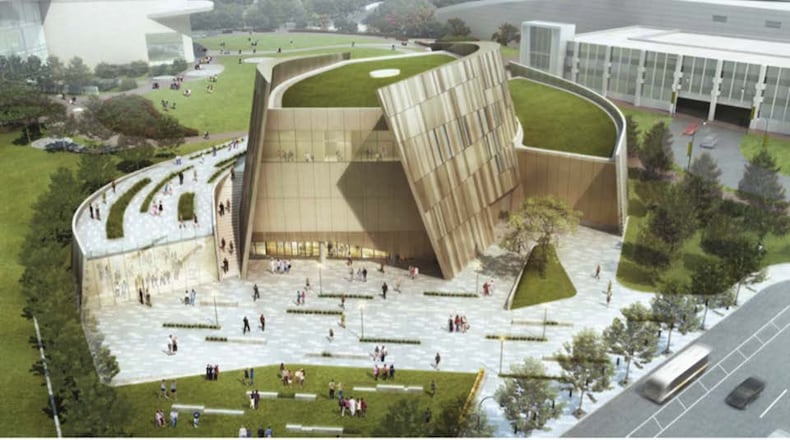The Arthur Blank Family Foundation announced a $17 million grant to the National Center for Civil and Human Rights on Thursday, a sum that is likely to be transformative for the downtown Atlanta landmark.
In a press conference with Arthur Blank, Jill Savitt, CEO of the center, said the grant brings the center halfway to its improvement campaign goal of $50 million. The money will support a major expansion of both the building in downtown Atlanta and the organization’s mission.
Two new wings will be added to the center, one named for Blank and the Blank Family Foundation, which will house galleries including a reimagining of the current exhibition of the Rev. Martin Luther King Jr. papers. About $15 million of the Blank grant will help fund a new 15,000-square-foot, three-story wing on the center’s west side. The King papers will occupy the top level. A 2,700-square-foot gallery in the new lobby will house exhibits with a focus on explaining civil and human rights to children. On another floor, a 2,500 square-foot gallery will address difficult artifacts from lynchings, including postcards and other ephemera, as well as documents and materials from anti-lynching campaigns.
The remaining $2 million from the Blank grant will support that new programming. It will be distributed over five years.
An east wing, which has yet to be named, will house an innovation center for the center’s ongoing work on diversity and inclusion, anti-bias training and coaching for community leaders to deal with inequities in their neighborhoods and regions. The remaining $25 million of the campaign has yet to be raised, and money from that will go toward construction of the 5,000-square-foot, single story east wing.
“This is a time in our history when for many reasons we don’t see the kind of kindness and understanding and connectedness that I think represents truly the best of America and the best of the world,” Blank said. “So, I think this museum is a good reminder of where we’ve come from, where we’ve been, and it does acknowledge the successes that we’ve had, and it’s important to do that. But at the same time it’s critical, I think, to remember and reflect to understand the evidence of the truths of what our country and world has experienced and remind us of the work that still has to be done.”
Blank said it’s important the center expand its programming to children with age-appropriate exhibitions and activities because intolerance is often learned when kids are young, and the center could provide opportunities for them to learn about tolerance.
Savitt said, however, that the center’s goal over the next five years is to move away from being perceived as an attraction bracketed by popular tourist destinations such as the Georgia Aquarium, World of Coca-Cola and the College Football Hall of Fame. The center wants to move squarely into the field of human rights training, working with community, state, national and international organizations with similar missions.
“Our goal overall is to help people tap their own power to change the world around them,” Savitt said. “That’s what we believe our center can do because of the unbelievable stories that we tell, and we want to do that for all ages.”
In 2013, the Blank Foundation gave the center a $1.5 million grant for its initial construction.
The center has changed leadership several times since it opened in 2014, and in some ways, has struggled to define itself on the national stage. But with the arrival of Savitt in 2019, and the hiring last fall of former Atlanta History Center vice president and chief curator Calinda Lee as director of programming, the human rights center is moving aggressively to position itself as a leader in the field. Savitt said that, beginning in March, the center will spend the next year doing anti-bias training with all members of the Atlanta Police Department, and it will expand training to police departments in Los Angeles, Miami and Phoenix. It also plans to bolster its Truth and Transformation project to help communities and organizations wade through the difficult issues of racial injustice and systemic inequities.
About the Author
Keep Reading
The Latest
Featured



